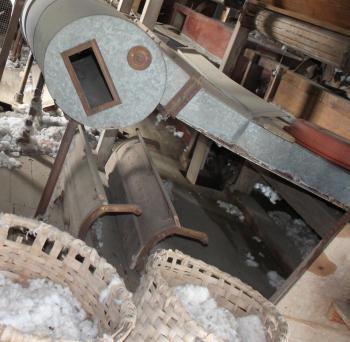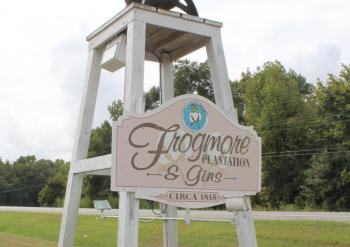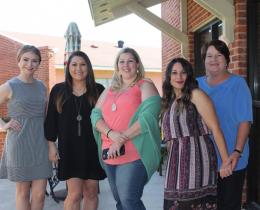
An open cotton boll is seen on the 1,800 acres of cotton at Frogmore Cotton Plantation and Gin, located near Ferriday. (Gazette photo by Raymond Partsch III)

The 1884 Munger steam-powered cotton gin at Frogmore Cotton Plantation and Gin, located near Ferriday. (Gazette photo by Raymond Partsch III)

Frogmore Cotton Plantation and Gin has 1,800 acres of fields of cotton. (Gazette photo by Raymond Partsch III)
Then and now
By: RAYMOND PARTSCH III
Managing Editor
FERRIDAY -- The sea of cotton appears to stretch all the way to the horizon.
The gentle, and ever so slightly, afternoon breeze, sways the rows upon rows of open bolls that engulf more than 1,000 acres located 20 miles west of the Mississippi River. The sight is one that the cotton kings of the antebellum South must have dreamed of, and one that also led many of those same titans to enslave thousands of people to cultivate the cash crop.
All of that and more is proudly on display for visitors to experience at the Frogmore Cotton Plantation and Gin, located outside of Ferriday.
Frogmore is a 1,800 acre working farm with a computerized touch-screen cotton gin, which produces 900 bales per day. The museum on the property meanwhile tells the vivid stories of the early Natchez planters, and the slaves and sharecroppers that toiled and resided on the land until the middle of the 20th Century.
“I firmly believe that anyone can do this,” co-owner Lynette Ater Tanner said. “Even though there is a lot of competition, if you create your niche that no one else has then you will succeed.”
The standard ‘Cotton... Then & Now’ tour begins in the property’s old general store, which was used during the sharecropping era, that is filled with a handful of authentic period items, like an old pecan cracker, but also serves as the museum’s ticket counter and gift shop.
After viewing a video on the history of the property in a slave log cabin from the late 1700’s, visitors will have a chance to tour more than the 18 restored antebellum structures, including slave quarters, dating from the 1800’s.
The original plantation house is not part of the tour as it serves as the Tanner’s family home.
Frogmore, which dates back to 1815 and has ancient Native-American mounds on it, went through multiple owners before the Wade family owned it for generations until Anna Wade Godbold’s death at the age of 101. Tanner’s husband George had already leased half of the estate in the 1960’s and then purchased the rest following Godbold’s passing.
Almost from the start, the Tanners had a desire to preserve the history of the property.
“It was something we wanted and talked about doing,” said Tanner, who grew up on family plantations in northeast Louisiana. “When Anna was still alive most of the region’s plantations had lost many of their historical buildings. A lot of the wooden buildings were hard to maintain and were torn down to make way for mechanism.”
A sizable portion of the buildings that currently stand today at Frogmore were either bought by the Tanners and relocated to Frogmore or were donated by other plantations, those buildings now bare the names of where each wooden structure was originally located.
The Tanners salvage project began when Lynette’s mother LaVonne donated two slave cabins to her daughter, in years shortly following the purchase of Frogmore. That ignited the Tanner’s passion for bringing back to life of what it meant to live on a cotton plantation.
The historic buildings on Frogmore include: a cooking cabin, a smokehouse, an overseer’s cottage, a church, a pigeonnier, a furnished double cabin that depicts a slave family’s quarters on one side and a sharecropper’s house on the other. There is also mill and barn filled 18th Century farming tools, mostly hand-held, and other farming implements.
Not to mention there is the crown jewel of the property, the 1884 Munger steam-powered gin, found near Rodney, Mississippi, which is listed on the National Register.
The tour wraps up with another informative video presentation of the plantation’s modern operation, including facts such as how long the cotton modules can last in the fields without being damaged (3-5 weeks) and the length of harvest season (September to October). Afterwards, visitors can also travel down the road to tour the modern operation.
“We are cotton producers, cotton ginners and warehousers,” Tanner said. “That is our main focus of our tour. There isn’t another site in the entire South that shows you how that is done.”
In the early days of the museum though, Tanner admits that visitors were few and far between.
“The first day we opened we had people,” Tanner said. “You first open and you think it is going to be that way all the time. Then days and days would go by and a single car wouldn’t stop.”
Unlike some other plantation tours throughout Louisiana and the South, Frogmore does not shy away from the topic of slavery. That topic is prevalent during the tour and there are several books about the subject in the gift shop, including “Chained to the Land: Voices from Cotton & Cane Planations,” a collection of slave narratives edited by Tanner herself.
“For years no one ever discussed slavery,” Tanner said. “It is a delicate subject and we try to present it fairly an factually. It was regretfully part of life worldwide and we have a duty to discuss it.”
Frogmore has developed a reputation as one of the premier tourism sites, as visitors come from Austria, Germany, France, Canada and Australia. The plantation has thousands of visitors each year, has been listed as a “As A Must See Site” by Rand McNally, and has been bestowed with numerous other awards.
Despite those accolades and success, Tanner is always looking at improving the experience. Frogmore has offered tours featuring live vocalists that relate the origins of the slave songs and gospels, tours focused on the blending of African and European cuisines and a Civil War tour.
Visitors can also handpick cotton throughout the year, with the exception being May and June.
“That’s been the idea from the inception,” Tanner said. “Once you have created a tour you always want to fine tune it. We had to offer our regular visitors alternative options.”
- Log in to post comments

